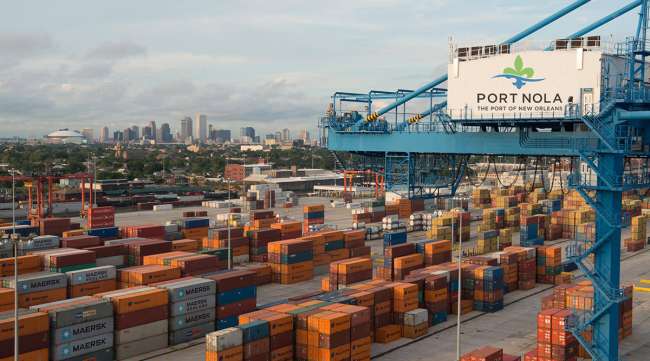Port of New Orleans ‘Evolution’ Could Include Billion-Dollar Project

Increasingly pressed for space upriver as cargo business continues to grow, Port of New Orleans officials are looking at the idea of building a new $1 billion-plus container terminal and distribution facility on a 675-acre undeveloped tract of land in nearby Meraux — a project that could create thousands of jobs and provide a major boost to St. Bernard Parish’s long-stagnant economy.
However, port officials are considering the Sinclair Tract site — owned by the Meraux Foundation — for building “more than just a container terminal,” according to the port’s president and CEO, Brandy Christian.
During a meeting last month with parish officials and economic development leaders, Christian described her vision for the expansion as “really creating a logistics hub that attracts businesses that rely on port access.”
“We really see St. Bernard as the evolution to our container business,” she said.
RELATED: Louisiana voters OK measure to tighten transportation spending
Port officials plan to begin discussing the proposed project with residents and getting their reactions at a public meeting at 6 p.m. Feb. 21 in the Parish Council chamber at the government complex in Chalmette.
Port officials stress that any final decision on whether to proceed is a year away. Recently, the port’s governing board hired global design-and-build firm AECOM to do a $300,000 feasibility study on whether the site, which is zoned for heavy-industrial use, can support a riverside container terminal and distribution complex.
Meanwhile, the idea of building a new container-oriented facility has gained traction in recent years as the New Orleans port has seen its container and break-bulk cargo business continue to grow.
The port’s Napoleon Avenue Container Terminal handled more than a half-million 20-foot equivalent units — a measure of cargo capacity for containerized shipping — in the 2017 fiscal year, which ended in June.
That number is expected to rise in coming years, with experts predicting an additional 400,000 20-foot equivalent units, or TEUs, will flow through the region between 2017 and 2020.
Meanwhile, the Napoleon Avenue facility is nearing its capacity — about 840,000 TEUs, though with room to build out to a footprint of about 1.5 million.
Christian estimated that a Meraux facility could generate 6,000 new jobs if it handles the same half-million TEUs as Napoleon did last year.
Still, the focus on St. Bernard far from rules out additional investment in New Orleans. In fact, the port is close to finishing a long-awaited master plan that will lay out its blueprint for growth over the next decade or more.
That document, expected to be released in coming months, will highlight plans for increasing the port’s capacity for handling both break-bulk and container cargo, as well as finding ways to revitalize undervalued industrial real estate along the Mississippi River, including in Jefferson and St. Bernard parishes.
The plan will include “significantly” investing in the Napoleon terminal, Christian told the crowd in St. Bernard, including equipment upgrades that will let the port maintain its current business there as well as grow it over the coming years.
But in order to prepare for additional growth down the line and to help alleviate stress on Uptown New Orleans, the port could decide to turn to the Meraux site, which could potentially accommodate large ships and additional maritime activity, such as logistics and distribution work, as well as additional businesses that rely on being near a port.
In her meeting with St. Bernard officials, Christian framed the project as not simply a positive for the port but potentially transformative for St. Bernard.
At this point, the port has entered into a deal with the Meraux Foundation, a charitable organization dedicated to the betterment of St. Bernard Parish, to study whether the site could work and weigh the project’s likely impact on the surrounding community.
To build the new facility, port officials envision using mostly private money, but with public funding for infrastructure upgrades, such as improving rail and roadway access.
Additionally, port officials hope to catch the eye of those planning President Donald Trump’s proposed $1.5 trillion infrastructure spending plan.
“We are optimistic that this project could potentially fit the criteria” for the Trump program, port spokeswoman Michelle Ganon said Feb. 20.
“It’s a big step to do this,” Christian said in the meeting. “We really wanted to be sure, especially when we signal to the market that, in order to be prepared for growth, we need a second container terminal.”
But so far, investors have responded affirmatively. “They said, ‘I’m in,’ “ Christian told the crowd. “I was shocked really, the bullishness of looking at Louisiana. I did not expect it would move this fast.”
It is unclear how nearby residents will respond to the project. At last month’s meeting, parish President Guy McInnis expressed excitement at the potential influx of economic activity into the parish, while also noting that some residents may hesitate at how it would affect their quality of life.
“We’re tired of just moseying on through St. Bernard. Where we’re at, we have this economic engine, the river, this money’s passing us all day,” McInnis said.
He urged residents not to rush to conclusions.
“We’re going to take a step back and we’re going to be open-minded and we’re going to allow Brandy and her team, the Port of New Orleans, to participate in this feasibility study over the next year,” he added.
Still, Christian noted that many questions remain to be answered before the port can make a decision. “It has to work for the community, it has to work for the residents, but it also has to be (economically) successful,” she said.
Distributed by Tribune Content Agency, LLC

